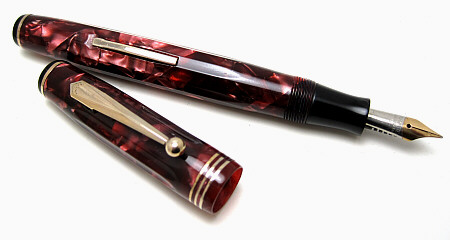The Pen That Started it All…
Tuesday, December 6th, 2011OK, almost started it all.
Back in the late 80s a co-worker gave a couple of pens to me. They had been her mothers, and she knew that I liked fountain pens. A simple Esterbrook SJ, and a Parker Parkette Deluxe. Nothing big but to a neophyte, exciting. Both needed to be repaired, but I had no idea how to do it. BUT, I had heard about this guy in Center City Philadelphia who “could repair any pen made, going back to 1900.” So I tracked the shop down, and sent my pens off to Mr Russel at Tuckers Pen Hospital down on Chestnut street, near I. Goldbergs, just a couple blocks west of Independence Mall. We won’t discuss my impatience to have the pen repaired.
The pen needed a nib, needed to be resaced, and generally restored. Total bill when he was done, an astonishing $145 and change. (For reference, in the late 80s he was charging $90 to restore a Sheaffer Snorkel). I still have the receipt somewhere, and may even have the shipping tube. I certainly do have the pen, 23 years or so later.

1st Quarter 1935 Parkette Deluxe
It’s a nice pen, great color, with a medium nib that writes smoothly. I don’t know where Mr Russel got his sacs, but I would love to know. I pulled the pen apart the other day, and found that the sac is as clean and fresh and good as it was the day it was installed. I know it’s the same sac because it’s stamped in bright orange Tuckers Pen Hospital.
The one think that I didn’t like was the treatment of the brassed trim. Everything was brassed. Since my parents lived about 30 miles outside of the city at the time, I went down to pick up the pen. When I commented on the brassed trim, he disappeared with the pen back into the repair area. My memory is that he appeared a bit later with the pen in hand, the trim shiny and bright. He said “I put something on it, nobody will ever know.” Except that I knew, and that the surface of the celluloid now had a slightly stippled look to it. The lacquer or whatever he sprayed on it eventually wore off, and the brassing was back. I finally took care of that little issue this past week by cleaning the metal, and then plating it. Now you can see why these were popular pens. Thin plating, yes, but still a quality Parker pen, comparable in size to the Challengers and Duofold Jrs of the day.
I sent one or two more little items off to Tuckers, and then quickly learned that if I wanted to collect on my radio engineer’s income, I needed to learn how to repair. About the same time, I came across repair manuals from the Pen Fancier’s Club and heard about the Pen Sac Co. The rest, as they say, is history. Within a year or so after receiving the Parkette I was haunting every antique show in town, and buying anything of interest just to be able to repair the pens. The habits and skills developed over 20 years ago are with me today – I still repair a pen as if it were going into my own collection, not just to push it out the door. It’s a habit that I don’t intend to change.
A footnote to the story. Years later David Isaacson called me and told me about a guy from Philadelphia who was selling a bunch of pen stuff. It seemed that his father had owned a pen repair shop in Philadelphia. As he rambled on I got to thinking, and then interrupted. “Is the guy’s last name Russel?” I asked. It was. The elder Mr Russel gone, the shop closed. But I will never forget visiting that little shop on the second floor down on Chestnut St, and the excitement of being in a pen repair shop, seeing other vintage pens, picking up my repaired Parkette and inking it.
I’m going to keep this pen – if nothing else to remind me of the wonder and excitement of being a new collector, and to get to ink that newly repaired pen for the first time. I repair pens, but what makes it special is to make the people who own them happy.